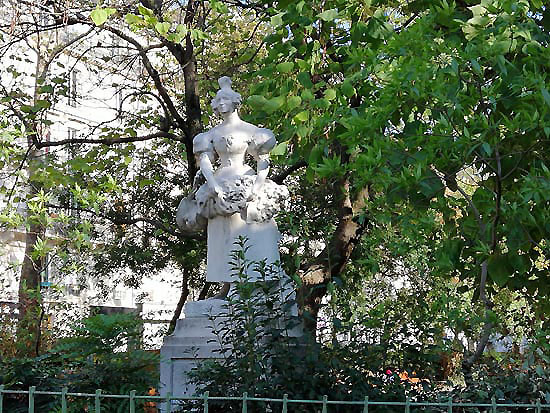"I RARELY SAW MY AUGUST SOVEREIGN SO ENTHUSIASTIC, SO MUCH DID HE VALUE THE MASTERLY LINE THAT COULD TAKE
THE FAUBOURG* SAINT-ANTOINE FROM BEHIND"
-- The baron Haussmann
in Éric Hazan, The Invention of Paris, 2001
*"Faubourg" or "false burg," that is, suburb.
That line becomes the passage over part of the Saint-Martin
canal, which in June hindered the army's march east:
-- On the canal
My canal Saint-Martin by Pascal Payen-Appenzeller (1984 (in French)
 | ||
|
The canal pierced through the faubourg Saint-Antoine, the artisans' territory that was the traditional epicenter of revolt.*
* A Balzacien character springs up"like an insurrection in the faubourg Saint-Antoine."
-- César Birotteau, 1837, cited by Hazan
Attack on a Barricade of rue Saint-Antoine and the Death of General Négrier on June 25 1848 by Gaspard Gobaut / zoom
Musée Carnavalet, not exhibited
Covering it would remove the obstacle that kept troops from entering the industrializing east as a whole, which was correctly expected to become more turbulent still:
 |
Barricade in Ménilmontant, 1871 / zoom |
So the "masterly line" was the covered-over canal, which let troops gathered at République pass over it to march through the Faubourg Saint-Antoine toward Bastille, or cross it to invade Belleville:
# # #
Haussmann transformed the entire area to allow the overpass.
- He demolished the "Boulevard of Crime," named after the melodramas produced in the theaters that lined the street...
 |
The Faubourg du Temple by Adolphe Martial Potémont, 1862 / zoom |
All that remains is the Théâtre Dejazet, on the other side of the street.
 |
The Children of Paradise by Marcel Carné (1943) with Arletty and Jean Marais / Trailer |
- To let the army assemble he built a huge space. At its center was a fountain that lions, symbols suitable to the Second Empire, surrounded.
By Michel Charles Fichot, toward 1880 / zoom
- When that regime imploded (in 1870) the Third Republic shakily appeared. An election finally ensconced it (in 1879), and the giant statue, Homage to the Republic, took the lion fountain's place (in 1883).
# # #
# # #
Today the "masterly line" is a series of gardens, with the July Column at one end and the statue "The Grisette* of 1830" at the other:
*Grisette: a working-class girl, who wore "gris" (gray) because gray cloth was cheapest.
By Jean Descamps, 1911
In Les Miserables, Fantine is a grisette whose lover, a student, takes her to a luxurious déjeuner. He promises a surprise to follow, which turns out to be leaving without paying the bill. He returns to his province, makes a useful marriage and never thinks of her again. She is pregnant... .
The statue charmingly reminds patriarchs
of the girlfriends of their youth,
while gardens make the violence
that led to the passage almost inconceivable.







.png)




No comments:
Post a Comment